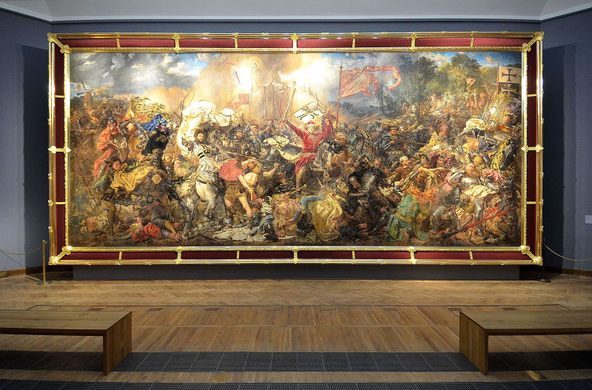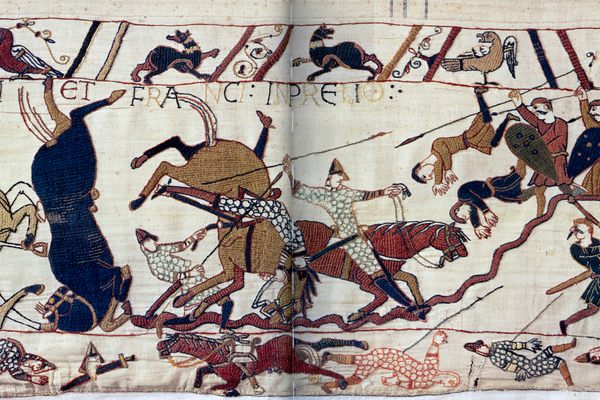AO Edited
Battle of Grunwald Painting
This enormous 32-foot painting depicts Poland's greatest medieval battle in glorious detail.
The Battle of Grunwald, fought in Poland in 1410, is known as one of the largest medieval battles in history. Roughly 13,000 lives were lost in this fierce fight between the Polish-Lithuanian alliance and the German-Prussian Knights of the Teutonic Order. The victorious outcome for Poland-Lithuania marked the rise of the Slavic state as a major European power and the beginning of the decline of the Teutonic Order.
The battle was a political one (about territorial expansion and control) between the Teutonic Knights that gained power during the Holy Crusades and has subsequently settled in the Mazovia region of Poland in 1226 on the invitation of Konrad Mazowiecki, a local ruler of the region that was not yet controlled by the Polish crown. Over time Teutonic Knights established their own country and became a military and political threat to the independent states of Poland and Lithuania (under the false pretense of christianization since Poland converted to christianity in 966 and Lithuania started converting in the late 1300s). Tensions escalated in 1409 when Lithuania and Poland openly supported local resistance against the Teutonic Knights and ultimately lead to the epic battle.
The Polish-Lithuanian forces under the command of Władysław Jagiełło (a Grand Duke of Lithuania who in 1386 became a king of Poland through a marriage to the young Polish queen) met with the Teutons at the Polish villages of Grunwald and Tannenberg and a standoff commenced. Historical records state that the Teutonic Knights were sure of their victory because of their superior armor, cavalry, and training. But they did not factor in the heat of the summer sun, which was literally cooking the soldiers inside their armor.
The Battle of Grunwald (also known as the Battle of Tannenberg) was fierce and many lives were lost, but the outcome was very much in favor of the Polish-Lithuanian army, which nearly destroyed the Teutons completely and gained back their independence. The battle ended with around 5,000 dead on the Polish-Lithuanian side versus 8,000 dead and 14,000 captured on the side of the Teutons.
In 1878, the Polish painter Jan Matejko immortalized the victory with a giant painting depicting the fighting in enormous detail. The artwork, displayed in the National Museum in Warsaw, follows a typical Renaissance style where multiple scenes flow into one and other. In the upper left part, we see the knight Dippold Kikeritz attacking the Polish king but being stopped and killed, which signifies the first signs of the Teutons losing the battle. In the middle, we see the Teutonic Grand Master being defeated by the joined armies in a glorious display. And on the right, we see the aftermath of the battle, where the Teutons are all but wiped out by their enemies.
The Battle of Grunwald is especially important to the Slavic countries whose ancestors participated in the war, and some organize yearly commemorations and historical reenactments of the historic victory. During the Soviet era, the Russians claimed the battle as a Russian one, as some of the soldiers came from regions that are now Russia. The Germans also never forgot this defeat, and called one of the battles they fought against Russia in World War I the “Battle of Tannenberg” as a way to claim revenge for what happened there centuries ago.
Update as of October 2021: The piece is currently not on display due to restoration work taking place in the museum. No confirmed date of its return.
Know Before You Go
The work is part of the permanent exhibition of the National Museum in Warsaw and has a room dedicated to its glory. The museum costs 20 zpl (roughly $5) for a regular ticket with various discounts for groups and students. Opening hours are Tuesday to Thursday from 10 a.m. to 6 p.m., Friday from 10 a.m. to 9 p.m., and Saturday and Sunday from 10 a.m. to 6 p.m. The museum is closed on Mondays.



















Follow us on Twitter to get the latest on the world's hidden wonders.
Like us on Facebook to get the latest on the world's hidden wonders.
Follow us on Twitter Like us on Facebook